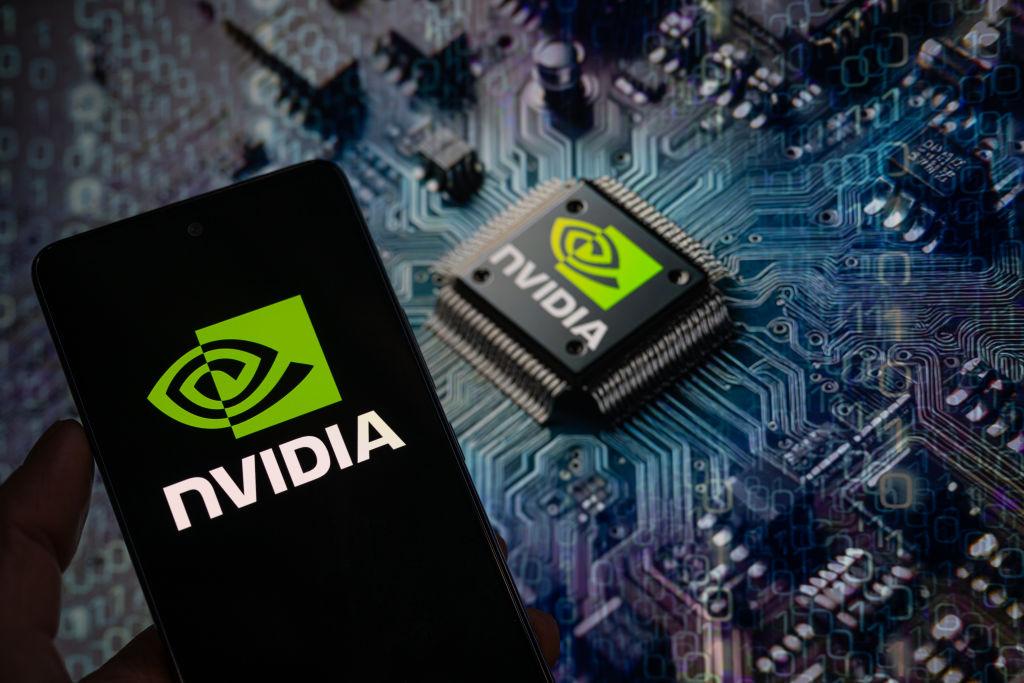If You'd Put $1,000 Into Nvidia Stock 20 Years Ago, Here's What You'd Have Today
Anyone shocked by Nvidia stock's wild ride should know that volatility has always been the price of admission to this long-time market beater.



Nvidia (NVDA) cemented its place as the market's favorite pure-play bet on artificial intelligence (AI) more than a year ago, and it shows no signs of letting up.
Indeed, the company has become so important to investors that Nvidia's earnings report helps set the tone for trading for the broader market.
To recap: seemingly insatiable demand on the part of monopolistic AI companies for Nvidia's graphics processing units (GPUs) propelled NVDA stock past $1 trillion in market capitalization midway through 2023. It took only about eight months for yet another blowout quarterly earnings report to push Nvidia stock past the $2 trillion mark.

Sign up for Kiplinger’s Free E-Newsletters
Profit and prosper with the best of expert advice on investing, taxes, retirement, personal finance and more - straight to your e-mail.
Profit and prosper with the best of expert advice - straight to your e-mail.
Cut to early 2024 when Nvidia's over-the-top first-quarter earnings – plus a NVDA stock split and a dividend hike – pushed its market cap past $3 trillion. As of this writing, Nvidia, which replaced Intel (INTC) in the Dow Jones Industrial Average in November, was the world's largest publicly traded company.
But then long-time shareholders should be used to such outsized rewards and risks by now.
That's because volatility has always been the price of admission to this long-time market beater. True, Nvidia, a highly cyclical semiconductor stock, has vastly outperformed the broader market since going public at the end of the last century.
Quite naturally, it has done so with several vertiginous ups and downs along the way.
But before we take a look at Nvidia stock's illustrious past, let's recap how it's been doing recently.
After losing half its value in 2022 – and attracting some bargain-hunting billionaire investors around its share-price nadir – NVDA stock more than tripled on a price basis in 2023, vs a gain of 24% for the S&P 500.
And as 2024? Nvidia stock gained more than 170% vs a 25% rise in the broader market.
Nvidia stock's market-beating ways go much farther back than most folks might know, however. In fact, few stocks have done more for investors over the past few decades than Nvidia. From its initial public offering at $12 a share in January 1999 through December 2020, NVDA stock created $309.4 billion in shareholder wealth, according to an analysis by Hendrik Bessembinder, a finance professor at the W.P. Carey School of Business at Arizona State University.
Indeed, per Bessembinder's findings, which account for a stock's increase in market value adjusted for cash flows in and out of the business and other factors, Nvidia is one of the 30 best stocks of the past 30 years.
Looked at another way, over its life as a publicly traded company, Nvidia stock generated an annualized total return of 36.2%. The S&P 500, with dividends reinvested, returned an annualized 10.5% over the same period.
Importantly, most of the shareholder wealth generated by Nvidia came over just the past few years. That's because back in the day, the primary market for Nvidia's GPUs consisted of PC and console video game enthusiasts.
Happily for Nvidia, it just so happens that the company's powerful GPUs and related intellectual property are indispensable to the fields of artificial intelligence, professional visualization, cryptocurrency mining and more. As noted above, NVDA processors are in demand for use in data centers – and especially data centers that power generative AI. Indeed, the company is struggling to keep up with demand.
Few blue chip stocks offer so much exposure to so many emerging endeavors, which helps explain NVDA stock's amazing returns over the longer haul. AI has been NVDA's afterburner.
But as remarkable as the company's business may be, it doesn't quite get to the heart of what NVDA stock has meant to long-term shareholders and their brokerage statements. For that, consider the following facts about Nvidia stock.
The bottom line on Nvidia stock?

Over the past two decades, Nvidia stock generated an annualized total return (price change plus dividends) of 37%. The S&P 500, by comparison, generated an annualized total return of 10.6% over the same span.
What does that mean in dollar terms? Have a look at the above chart and you'll see that if you invested $1,000 in Nvidia stock 20 years ago, it would today be worth more than $540,000. The same amount invested in the S&P 500 would theoretically be worth about $7,150 today.
As for adding to NVDA at current levels, the Street remains bullish even after the stock's incredible run. Indeed, NVDA ranks as the top Dow Jones stock to buy.
Of the 63 analysts issuing opinions on Nvidia stock surveyed by S&P Global Market Intelligence, 47 rate it at Strong Buy, 11 say Buy and five call it a Hold. That works out to a rare consensus recommendation of Strong Buy. Indeed, Nvidia ranks among analysts' top S&P 500 stocks to buy now.
Just remember that NVDA is a ultimately a chip company. The semiconductor industry is cyclical. Once everyone who needs AI chips has them, Nvidia's growth prospects could change.
More Stocks of the Past 20 Years
- If You'd Put $1,000 Into Microsoft Stock 20 Years Ago, Here's What You'd Have Today
- If You'd Put $1,000 Into Apple Stock 20 Years Ago, Here's What You'd Have Today
- If You'd Put $1,000 Into Walmart Stock 20 Years Ago, Here's What You'd Have Today
Get Kiplinger Today newsletter — free
Profit and prosper with the best of Kiplinger's advice on investing, taxes, retirement, personal finance and much more. Delivered daily. Enter your email in the box and click Sign Me Up.

Dan Burrows is Kiplinger's senior investing writer, having joined the august publication full time in 2016.
A long-time financial journalist, Dan is a veteran of MarketWatch, CBS MoneyWatch, SmartMoney, InvestorPlace, DailyFinance and other tier 1 national publications. He has written for The Wall Street Journal, Bloomberg and Consumer Reports and his stories have appeared in the New York Daily News, the San Jose Mercury News and Investor's Business Daily, among many other outlets. As a senior writer at AOL's DailyFinance, Dan reported market news from the floor of the New York Stock Exchange.
Once upon a time – before his days as a financial reporter and assistant financial editor at legendary fashion trade paper Women's Wear Daily – Dan worked for Spy magazine, scribbled away at Time Inc. and contributed to Maxim magazine back when lad mags were a thing. He's also written for Esquire magazine's Dubious Achievements Awards.
In his current role at Kiplinger, Dan writes about markets and macroeconomics.
Dan holds a bachelor's degree from Oberlin College and a master's degree from Columbia University.
Disclosure: Dan does not trade individual stocks or securities. He is eternally long the U.S equity market, primarily through tax-advantaged accounts.
-
 6 Stunning Waterfront Homes for Sale Around the US
6 Stunning Waterfront Homes for Sale Around the USFrom private peninsulas to lakes, bayous and beyond, Kiplinger's "Listed" series brings you another selection of dream homes for sale on the waterfront.
By Charlotte Gorbold Published
-
 Six Reasons to Disinherit Someone and How to Do It
Six Reasons to Disinherit Someone and How to Do ItWhether you're navigating a second marriage, dealing with an estranged relative or leaving your assets to charity, there are reasons to disinherit someone. Here's how.
By Donna LeValley Published
-
 Should You Still Wait Until 70 to Claim Social Security?
Should You Still Wait Until 70 to Claim Social Security?Delaying Social Security until age 70 will increase your benefits. But with shortages ahead, and talk of cuts, is there a case for claiming sooner?
By Evan T. Beach, CFP®, AWMA® Published
-
 Retirement Planning for Couples: How to Plan to Be So Happy Together
Retirement Planning for Couples: How to Plan to Be So Happy TogetherPlanning for retirement as a couple is a team sport that takes open communication, thoughtful planning and a solid financial strategy.
By Andrew Rosen, CFP®, CEP Published
-
 Market Turmoil: What History Tells Us About Current Volatility
Market Turmoil: What History Tells Us About Current VolatilityThis up-and-down uncertainty is nerve-racking, but a look back at previous downturns shows that the markets are resilient. Here's how to ride out the turmoil.
By Michael Aloi, CFP® Published
-
 Stock Market Today: Stocks Surge to Close a Volatile Week
Stock Market Today: Stocks Surge to Close a Volatile WeekIt was another day with a week's worth of both news and price action, but it ended on a strongly positive note.
By David Dittman Published
-
 Home Insurance: How to Cut Costs Without Losing Coverage
Home Insurance: How to Cut Costs Without Losing CoverageNatural disasters are causing home insurance premiums to soar, but don't risk dropping your coverage completely when there are ways to keep costs down.
By Jared Elson, Investment Adviser Published
-
 Markets Roller Coaster: Resist the Urge to Make Big Changes
Markets Roller Coaster: Resist the Urge to Make Big ChangesYou could do more harm than good if you react emotionally to volatility. Instead, consider tax-loss harvesting, Roth conversions and how to plan for next time.
By Frank J. Legan Published
-
 Why Homeowners Insurance Has Gotten So Very Expensive
Why Homeowners Insurance Has Gotten So Very ExpensiveThe home insurance industry is seeing more frequent and bigger claims because of weather, wildfires and other natural disasters.
By Karl Susman, CPCU, LUTCF, CIC, CSFP, CFS, CPIA, AAI-M, PLCS Published
-
 Stock Market Today: Uncertainty Proliferates: Dow Loses 1,014 Points
Stock Market Today: Uncertainty Proliferates: Dow Loses 1,014 PointsWeaker-than-expected consumer inflation data wasn't enough to stabilize sentiment during another volatile day for financial markets.
By David Dittman Published